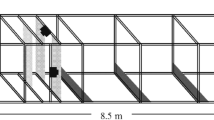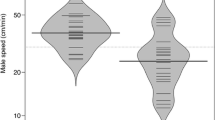Abstract
Males advertise their intrinsic parental and/or genetic qualities by the size of secondary sexual ornaments. Moreover, they compete with one another for the best territory and males who arrive first at the breeding ground usually have an advantage in this competition. Females may consider multiple male qualities simultaneously and prefer the one most important for their fitness in the current context. They can further improve their fitness by selecting the best care-giver as their social mate and engaging in an extra-pair copulation with a genetically superior male. In such cases, sperm competition arises in the female reproductive tract and its outcome may be affected by the sperm morphology of both the social and extra-pair male. Here, we tested these ideas in the collared flycatcher (Ficedula albicollis), a species with context-dependent choice of social partners and frequent extra-pair paternity. We recorded male arrival to breeding sites, manipulated their forehead patches, and measured sperm size. In contrast to a previous study in a Swedish population, males with enlarged patches were non-significantly less successful late in the season while no such difference was found early in the season. Besides this tendential seasonal interaction, arrival date did not affect mating and paternity success or male fitness, and the same was true for sperm size. These results suggest different benefits of male ornamentation and female mate choice between populations and call for more replicated research within and between species.
Significance statement
The fitness of a male of a migratory species might be affected by several pathways. First, early arrival should confer benefits in the form of best territory choice. Second, in a dichromatic and sexually promiscuous species, secondary sexual ornaments are considered by females both in the choice of social and extra-pair mates. Third, by modifying sperm traits, males may outmatch their rivals in sperm competition. These ideas have usually been tested in isolation. In this experimental study, we tested the joint effect of all of these factors on the genetic fitness of males. We found little evidence for the dependence of male reproductive success on either sperm morphology or plumage ornamentation which is in contrast to other populations of the species. Our study calls for replicated research both in well-established fields like mate choice and emerging ones like sperm competition.



Similar content being viewed by others
References
Aebischer A, Perrin N, Krieg M, Studer J, Meyer DR (1996) The role of territory choice, mate choice and arrival date on breeding success in the Savi’s Warbler Locustella luscinioides. J Avian Biol 27:143–152
Akçay E, Roughgarden J (2007) Extra-pair paternity in birds : review of the genetic benefits. Evol Ecol Res 9:855–868
Alatalo RV, Lundberg A, Glynn C (1986) Female pied flycatchers choose territory quality and not male characteristics. Nature 323:152–153
Andersson M (1994) Sexual selection. Princeton University Press, Princeton
Beck ML (2013) Nest-box acquisition is related to plumage coloration in male and female prothonotary warblers (Protonotaria citrea). Auk 130:364–371
Bennison C, Hemmings N, Slate J, Birkhead T (2015) Long sperm fertilize more eggs in a bird. Proc R Soc B 282:20141897
Birkhead TR, Hunter FM, Pellatt E (1989) Sperm competition in the zebra finch, Taeniopygia guttata. Anim Behav 38:935–950
Birkhead TR, Martinez JG, Burke T, Froman DP (1999) Sperm mobility determines the outcome of sperm competition in the domestic fowl. Proc R Soc Lond B 266:1759–1764
Callander S, Backwell PRY, Jennions MD (2012) Context-dependent male mate choice: the effects of competitor presence and competitor size. Behav Ecol 23:355–360
Cleasby IR, Nakagawa S (2012) The influence of male age on within-pair and extra-pair paternity in passerines. Ibis 154:318–324
Cramer ERA, Laskemoen T, Kleven O, Lebarbera K, Lovette IJ, Lifjeld JT (2013) No evidence that sperm morphology predicts paternity success in wild house wrens. Behav Ecol Sociobiol 67:1845–1853
de Heij ME, Gustafsson L, Brommer JE (2011) Experimental manipulation shows that the white wing patch in collared flycatchers is a male sexual ornament. Ecol Evol 1:546–555
Drăgănoiu TI, Nagle L, Kreutzer M (2002) Directional female preference for an exaggerated male trait in canary (Serinus canaria) song. Proc R Soc Lond B 269:2525–2531
Edme A, Munclinger P, Krist M (2016) Female collared flycatchers choose neighbouring and older extra-pair partners from the pool of males around their nests. J Avian Biol 47:552–562
Ellegren H (1992) Polymerase-chain-reaction (PCR) analysis of microsatellites—a new approach to studies of genetic relationships in birds. Auk 109:886–895
Garamszegi LZ, Rosivall B, Hegyi G, Szöllösi E, Török J, Eens M (2006) Determinants of male territorial behavior in a Hungarian collared flycatcher population: plumage traits of residents and challengers. Behav Ecol Sociobiol 60:663–671
Gentner TQ, Hulse SH (2000) Female European starling preference and choice for variation in conspecific male song. Anim Behav 59:443–458
Gibbs HL, Tabak LM, Hobson K (1999) Characterization of microsatellite DNA loci for a neotropical migrant songbird, the Swainson’s thrush (Catharus ustulatus). Mol Ecol 8:1551–1561
Grana SC, Sakaluk SK, Bowden RM, Doellman MA, Vogel LA, Thompson CF (2012) Reproductive allocation in female house wrens is not influenced by experimentally altered male attractiveness. Behav Ecol Sociobiol 66:1247–1258
Griffith SC, Owens IPF, Burke T (1999) Female choice and annual reproductive success favour less-ornamented male house sparrows. Proc R Soc Lond B 266:765–770
Gustafsson L, Qvarnström A, Sheldon BC (1995) Trade-offs between life history traits and a secondary sexual character in male collared flycatchers. Nature 375:311–313
Hale RE (2008) Evidence that context-dependent mate choice for parental care mirrors benefits to offspring. Anim Behav 75:1283–1290
Hegyi G, Török J, Toth L (2002) Qualitative population divergence in proximate determination of a sexually selected trait in the collared flycatcher. J Evol Biol 15:710–719
Horváthová T, Nakagawa S, Uller T (2012) Strategic female reproductive investment in response to male attractiveness in birds. Proc R Soc Lond B 279:163–170
Hoyt DF (1979) Practical methods of estimating volume and fresh weight of birds’ eggs. Auk 96:73–77
Jennions MD, Petrie M (2000) Why do females mate multiply? A review of the genetic benefits. Biol Rev 75:21–64
Kalinowski ST, Taper ML, Marshall TC (2007) Revising how the computer program CERVUS accommodates genotyping error increases success in paternity assignment. Mol Ecol 16:1099–1106
Kempenaers B, Verheyen G, Van den Broeck M, Burke T, Van Broeckhoven C, Dhondt A (1992) Extra-pair paternity results from female preference for high quality males in the blue tit. Nature 357:494–496
Krist M (2009) Short- and long-term effects of egg size and feeding frequency on offspring quality in the collared flycatcher (Ficedula albicollis). J Anim Ecol 78:907–918
Krist M, Munclinger P (2011) Superiority of extra-pair offspring: maternal but not genetic effects as revealed by a mixed cross-fostering design. Mol Ecol 20:5074–5091
Krist M, Nádvorník P, Uvírová L, Bureš S (2005) Paternity covaries with laying and hatching order in the collared flycatcher Ficedula albicollis. Behav Ecol Sociobiol 59:6–11
Laskemoen T, Kleven O, Fossøy F, Robertson RJ, Rudolfsen G, Lifjeld JT (2010) Sperm quantity and quality effects on fertilization success in a highly promiscuous passerine, the tree swallow Tachycineta bicolor. Behav Ecol Sociobiol 64:1473–1483
Leder EH, Karaiskou N, Primmer CR (2008) Seventy new microsatellites for the pied flycatcher, Ficedula hypoleuca and amplification in other passerine birds. Mol Ecol Resour 8:874–880
Lifjeld JT, Slagsvold T, Ellegren H (1997) Experimental mate switching in pied flycatchers: male copulatory access and fertilization success. Anim Behav 53:1225–1232
Lifjeld JT, Laskemoen T, Kleven O, Albrecht T, Robertson RJ (2010) Sperm length variation as a predictor of extrapair paternity in passerine birds. PLoS One 5:e13456
Mazuc J, Chastel O, Sorci G (2003) No evidence for differential maternal allocation to offspring in the house sparrow (Passer domesticus). Behav Ecol 14:340–346
Mitchell DP, Dunn PO, Whittingham LA, Freeman-Gallant CR (2007) Attractive males provide less parental care in two populations of the common yellowthroat. Anim Behav 73:165–170
Møller AP (2004) Protandry, sexual selection and climate change. Glob Change Biol 10:2028–2035
Møller AP, Birkhead TR (1993) Cuckoldry and sociality: a comparative study of birds. Am Nat 142:118–140
Mougeot F (2004) Breeding density, cuckoldry risk and copulation behaviour during the fertile period in raptors: a comparative analysis. Anim Behav 67:1067–1076
Pärt T, Qvarnström A (1997) Badge size in collared flycatchers predicts outcome of male competition over territories. Anim Behav 54:893–899
Quay WB (1986) Cloacal protuberance and cloacal sperm in passerine birds: comparative study of quantitative relations. Condor 88:160–168
Qvarnström A (1997) Experimentally increased badge size increases male competition and reduces male parental care in the collared flycatcher. Proc R Soc Lond B 264:1225–1231
Qvarnström A (1999) Different reproductive tactics in male collared flycatchers signalled by size of secondary sexual character. Proc R Soc Lond B 266:2089–2093
Qvarnström A (2001) Context-dependent genetic benefits from mate choice. Trends Ecol Evol 16:5–7
Qvarnström A, Pärt T, Sheldon BC (2000) Adaptive plasticity in mate preference linked to differences in reproductive effort. Nature 405:344–347
R Core Team (2014). R: A language and environment for statistical computing. R Foundation for Statistical Computing, Vienna, Austria, http://www.R-project.org/
Richardson DS, Burke T (1999) Extra-pair paternity in relation to male age in Bullock’s orioles. Mol Ecol 8:2115–2126
Rosivall B, Szöllösi E, Hasselquist D, Török J (2009) Effects of extrapair paternity and sex on nestling growth and condition in the collared flycatcher, Ficedula albicollis. Anim Behav 77:611–617
Scordato ESC, Safran RJ (2014) Geographic variation in sexual selection and implications for speciation in the Barn Swallow. Avian Res 5:8
Sheldon BC (2000) Differential allocation: tests, mechanisms and implications. Trends Ecol Evol 15:397–402
Sheldon BC, Ellegren H (1999) Sexual selection resulting from extrapair paternity in collared flycatchers. Anim Behav 57:285–298
Sheldon BC, Merilä J, Qvarnström A, Gustafsson L, Ellegren H (1997) Paternal genetic contribution to offspring condition predicted by size of male secondary sexual character. Proc R Soc Lond B 264:297–302
Smith CC (2012) Opposing effects of sperm viability and velocity on the outcome of sperm competition. Behav Ecol 23:820–826
Snook RR (2005) Sperm in competition: not playing by the numbers. Trends Ecol Evol 20:46–53
Török J, Hegyi G, Garamszegi LZ (2003) Depigmented wing patch size is a condition-dependent indicator of viability in male collared flycatchers. Behav Ecol 14:382–388
Tottrup AP, Thorup K (2008) Sex-differentiated migration patterns, protandry and phenology in North European songbird populations. J Ornithol 149:161–167
Acknowledgments
We thank Andrea Höchsmannová, Martin Janča, Tomáš Koutný, Jan Stříteský, Jan Vidlař, and Pavlína Vymazalová for help in the field and Jessica Cuthbert for corrections of the English. Comments of two anonymous reviewers greatly improved the quality of the manuscript. Martin Janča and Oldřich Tomášek helped with our pre-experiment in zebra finches. MK thanks Kačka for support.
Author information
Authors and Affiliations
Corresponding author
Ethics declarations
Funding
This study was funded by the Grant Agency of the Czech Republic (206/07/P485 and P506/12/2472) and IGA UPOL (IGA_PrF_2016_004).
Conflict of interest
The authors declare that they have no conflict of interest.
Ethical approval
This study was approved by the ethical committee of Palacky University and by the Ministry of Education, Youth and Sports (license number: MSMT-56147/2012-310) and complies with the current laws of the Czech Republic.
Additional information
Communicated by S. Pruett-Jones
Electronic supplementary material
ESM 1
(DOCX 1199 kb)
Rights and permissions
About this article
Cite this article
Edme, A., Zobač, P., Opatová, P. et al. Do ornaments, arrival date, and sperm size influence mating and paternity success in the collared flycatcher?. Behav Ecol Sociobiol 71, 3 (2017). https://doi.org/10.1007/s00265-016-2242-8
Received:
Revised:
Accepted:
Published:
DOI: https://doi.org/10.1007/s00265-016-2242-8




